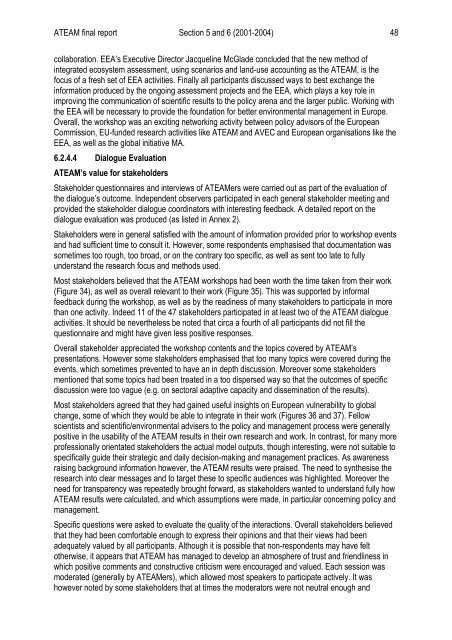ateam - Potsdam Institute for Climate Impact Research
ateam - Potsdam Institute for Climate Impact Research
ateam - Potsdam Institute for Climate Impact Research
You also want an ePaper? Increase the reach of your titles
YUMPU automatically turns print PDFs into web optimized ePapers that Google loves.
ATEAM final report Section 5 and 6 (2001-2004) 48<br />
collaboration. EEA’s Executive Director Jacqueline McGlade concluded that the new method of<br />
integrated ecosystem assessment, using scenarios and land-use accounting as the ATEAM, is the<br />
focus of a fresh set of EEA activities. Finally all participants discussed ways to best exchange the<br />
in<strong>for</strong>mation produced by the ongoing assessment projects and the EEA, which plays a key role in<br />
improving the communication of scientific results to the policy arena and the larger public. Working with<br />
the EEA will be necessary to provide the foundation <strong>for</strong> better environmental management in Europe.<br />
Overall, the workshop was an exciting networking activity between policy advisors of the European<br />
Commission, EU-funded research activities like ATEAM and AVEC and European organisations like the<br />
EEA, as well as the global initiative MA.<br />
6.2.4.4 Dialogue Evaluation<br />
ATEAM’s value <strong>for</strong> stakeholders<br />
Stakeholder questionnaires and interviews of ATEAMers were carried out as part of the evaluation of<br />
the dialogue’s outcome. Independent observers participated in each general stakeholder meeting and<br />
provided the stakeholder dialogue coordinators with interesting feedback. A detailed report on the<br />
dialogue evaluation was produced (as listed in Annex 2).<br />
Stakeholders were in general satisfied with the amount of in<strong>for</strong>mation provided prior to workshop events<br />
and had sufficient time to consult it. However, some respondents emphasised that documentation was<br />
sometimes too rough, too broad, or on the contrary too specific, as well as sent too late to fully<br />
understand the research focus and methods used.<br />
Most stakeholders believed that the ATEAM workshops had been worth the time taken from their work<br />
(Figure 34), as well as overall relevant to their work (Figure 35). This was supported by in<strong>for</strong>mal<br />
feedback during the workshop, as well as by the readiness of many stakeholders to participate in more<br />
than one activity. Indeed 11 of the 47 stakeholders participated in at least two of the ATEAM dialogue<br />
activities. It should be nevertheless be noted that circa a fourth of all participants did not fill the<br />
questionnaire and might have given less positive responses.<br />
Overall stakeholder appreciated the workshop contents and the topics covered by ATEAM’s<br />
presentations. However some stakeholders emphasised that too many topics were covered during the<br />
events, which sometimes prevented to have an in depth discussion. Moreover some stakeholders<br />
mentioned that some topics had been treated in a too dispersed way so that the outcomes of specific<br />
discussion were too vague (e.g. on sectoral adaptive capacity and dissemination of the results).<br />
Most stakeholders agreed that they had gained useful insights on European vulnerability to global<br />
change, some of which they would be able to integrate in their work (Figures 36 and 37). Fellow<br />
scientists and scientific/environmental advisers to the policy and management process were generally<br />
positive in the usability of the ATEAM results in their own research and work. In contrast, <strong>for</strong> many more<br />
professionally orientated stakeholders the actual model outputs, though interesting, were not suitable to<br />
specifically guide their strategic and daily decision-making and management practices. As awareness<br />
raising background in<strong>for</strong>mation however, the ATEAM results were praised. The need to synthesise the<br />
research into clear messages and to target these to specific audiences was highlighted. Moreover the<br />
need <strong>for</strong> transparency was repeatedly brought <strong>for</strong>ward, as stakeholders wanted to understand fully how<br />
ATEAM results were calculated, and which assumptions were made, in particular concerning policy and<br />
management.<br />
Specific questions were asked to evaluate the quality of the interactions. Overall stakeholders believed<br />
that they had been com<strong>for</strong>table enough to express their opinions and that their views had been<br />
adequately valued by all participants. Although it is possible that non-respondents may have felt<br />
otherwise, it appears that ATEAM has managed to develop an atmosphere of trust and friendliness in<br />
which positive comments and constructive criticism were encouraged and valued. Each session was<br />
moderated (generally by ATEAMers), which allowed most speakers to participate actively. It was<br />
however noted by some stakeholders that at times the moderators were not neutral enough and
















